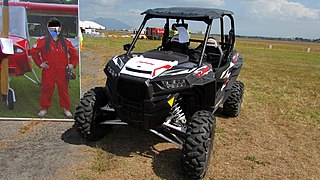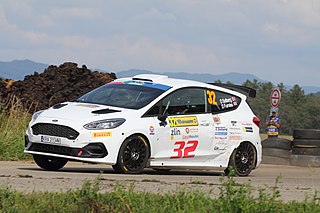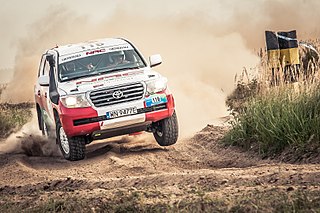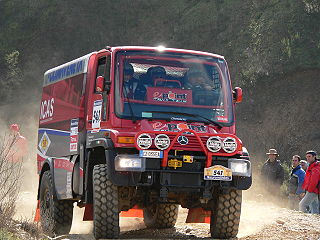
Group A is a set of motorsport regulations administered by the FIA covering production derived touring cars for competition, usually in touring car racing and rallying. In contrast to the short-lived Group B and Group C, Group A vehicles were limited in terms of power, weight, allowed technology and overall cost. Group A was aimed at ensuring numerous entries in races of privately owned vehicles.

Group B was a set of regulations for grand touring (GT) vehicles used in sports car racing and rallying introduced in 1982 by the Fédération Internationale de l'Automobile (FIA). Although permitted to enter a GT class of the World Sportscar Championship alongside the more popular racing prototypes of Group C, Group B are commonly associated with the international rallying scene during 1982 to 1986 in popular culture, when they were the highest class used across rallying, including the World Rally Championship, regional and national championships.

In relation to international motorsport governed by the FIA, Group N refers to regulations providing "standard" large-scale series production vehicles for competition. They are limited in terms of modifications permitted to the standard specification by the manufacturer making them a cost effective method of production vehicle motorsport. Often referred to as the "showroom class", Group N contrasts with Group A which has greater freedom to modify and tune the cars to be more suitable to racing. Both groups may have the same or similar models homologated by a manufacturer.
The International Sporting Code (ISC) is a set of rules applicable to motorsport governed by the Fédération Internationale de l'Automobile (FIA). North American domestic racing, such as NASCAR and IndyCar are outside the FIA's jurisdiction and hence not governed by the ISC. Motorcycle sport is also exempt since the Fédération Internationale de Motocyclisme (FIM) is responsible for this sport, not the FIA.
Group 5 was an FIA motor racing classification which was applied to four distinct categories during the years 1966 to 1982. Initially Group 5 regulations defined a Special Touring Car category and from 1970 to 1971 the classification was applied to limited production Sports Cars restricted to 5 litre engine capacity. The Group 5 Sports Car category was redefined in 1972 to exclude the minimum production requirement and limit engine capacity to 3 litres. From 1976 to 1982 Group 5 was for Special Production Cars, a liberal silhouette formula based on homologated production vehicles.

The Group 4 racing class referred to regulations for cars in sportscar racing, GT racing and rallying, as regulated by the FIA. The Group 4 class was replaced by Group B for the 1983 season.

The Group 3 racing class referred to a set of regulations for Grand Touring Cars competing in sportscar racing and rallying events regulated by the FIA. These regulations were active, in various forms, from 1957 to 1981.
Group 6 was the official designation applied by the FIA to two motor racing classifications, the Prototype-Sports Car category from 1966 to 1971 and the Two-Seater Racing Cars class from 1976 to 1982.

The Group 2 racing class referred to regulations for cars in touring car racing and rallying, as regulated by the FIA. Group 2 was replaced by Group A in 1982.
Group 7 was a set of regulations for automobile racing created by the Commission Sportive Internationale (CSI), a division of the modern Fédération Internationale de l'Automobile.
Group E is a formula racing class governed by the FIA for racing cars. Group E was first mentioned in Appendix J of the International Sporting Code in 1990.

In relation to motorsport, Group T4 is a set of technical specifications for modified production cross-country side-by-side vehicles used in off-road Cross-Country Rallying. The group is governed by the Fédération Internationale de l'Automobile (FIA) and defined in appendix J, article 286a of its International Sporting Code. The vehicles are modified for competition purposes from vehicles manufactured in numbers greater than 250 in a 12 month period. They must be road legal, but typically differ from the 'cars' defined in Group T1 and Group T2 by a much lower minimum weight (900 kg)and no requirement for parts such as a windscreen or windows. The vehicles must be powered by one engine and without driving aids such as traction control or ABS. Though the vehicles do not need to be homologated, a reference vehicle needs to be provided to the FIA for approval.

The Group N-GT was a motor racing category launched by the Fédération Internationale de l'Automobile in 2000. The first cars were homologated on 1 March, 2000 by Porsche and Ferrari. A total of eight different models from six marques were homologated throughout the class existence.

In the motorsport discipline of rallying, Group Rally3 is a formula of rally car specification determined by the FIA for use in its international competitions: the World Rally Championship (WRC) and regional championships. National rallying competitions also allow Group Rally3 cars to compete. There are three technical subclasses of Group Rally3 however these do not affect competitive eligibility so 'Rally3' may be used alone with the same definition. The group was launched in 2021 with the homologation of the first car after the introduction of the Rally Pyramid initiative to reorganise the classes of car and championships in international rallying was approved in June 2018.

In the motorsport discipline of rallying, Group Rally5 is a formula of rally car specification determined by the FIA for use in its international rallying competitions: World Rally Championship (WRC) and regional championships. National rallying competitions also allow Group Rally5 cars to compete. There are no subclasses of the group therefore all Group Rally5 cars can compete in the same category. 'Rally5' may be used alone with the same definition. The group was launched in 2019 after the introduction of the Rally Pyramid initiative to reorganise the classes of car and championships in international rallying was approved in June 2018.

In relation to motorsport, Group T1 is a set of technical specifications for prototype cross-country cars used in off-road Cross-Country Rallying. The group is governed by the Fédération Internationale de l'Automobile (FIA) and defined in appendix J, article 285 of its International Sporting Code. The cars are single unit builds and may be based on a spaceframe chassis unlike the strict series production bodyshell requirement in Group T2. However, the engine must come from, or be derived from a production car able to be homologated in Group A, Group GT or Group T2. The cars must be powered by one engine and without driving aids such as traction control or ABS.

In relation to motorsport, Group T2 is a set of technical specifications for series production cross-country cars used in off-road Cross-Country Rallying. The group is governed by the Fédération Internationale de l'Automobile (FIA) and defined in appendix J, article 284 of its International Sporting Code. The cars must use a bodyshell and apart from safety features such as a roll cage and upgraded suspension and wheels, must retain features of the series production car unlike the thoroughbred race prototypes in Group T1, which have more freedom surrounding the chassis build and other parts. The cars in T2 must be homologated with a series production build requirement of 1000 identical units.

In relation to motorsport, Group T3 is a set of technical specifications for lightweight prototype cross-country vehicles used in off-road Cross-Country Rallying. The group is governed by the Fédération Internationale de l'Automobile (FIA) and defined in appendix J, article 286 of its International Sporting Code. The vehicles are generally single unit builds for competition purposes, and differ from 'cars' defined in Group T1 by not needing to be road-legal, and have a much lower minimum weight. The T3 vehicles also do not need parts such as a windscreen or an engine manufactured by series production car companies. The vehicles must be powered by one engine and without driving aids such as traction control or ABS. Although not specifically defined as such by the FIA, the group may be called prototype side-by-side vehicles, like their series production relatives of Group T4. Indeed, T3 permits such modified and competition prepared vehicles where T4 prohibits them.

In relation to motorsport, Group T5 is a set of technical specifications for prototype cross-country trucks used in off-road Cross-Country Rallying. The group is governed by the Fédération Internationale de l'Automobile (FIA) and defined in appendix J, article 287 of its International Sporting Code.
In motorsport, Group D is for international formula racing cars classified by the Fédération Internationale de l'Automobile in Appendix J of its International Sporting Code. The group was first described in Article 251 "Classification and Definitions", in 1982 along with the simultaneous introduction of Groups N, A, B, C and E. Group D was placed in Category II for Competition Cars, cars that were single builds for racing purposes only. The Group continued to be defined in new publications of Appendix J Article 251, usually annually, until 2019. Although Appendix J does define Formula 2 and Formula 3 as "international formulae", neither have ever been explicitly defined as being in or consisting of Group D in their respective technical or specific regulations. Further, Group D is not mentioned anywhere else in the International Sporting Code or its appendices other than the initial classification and definition in Article 251.















